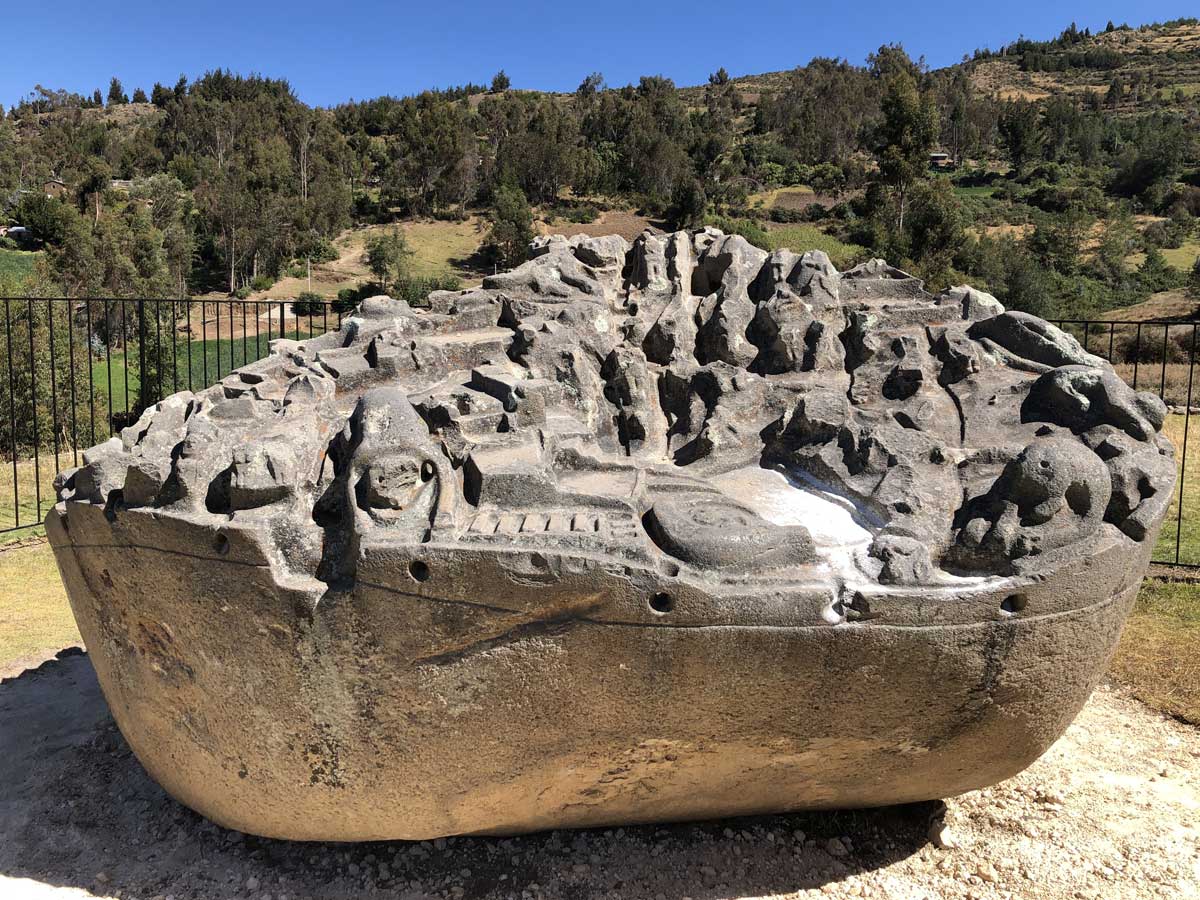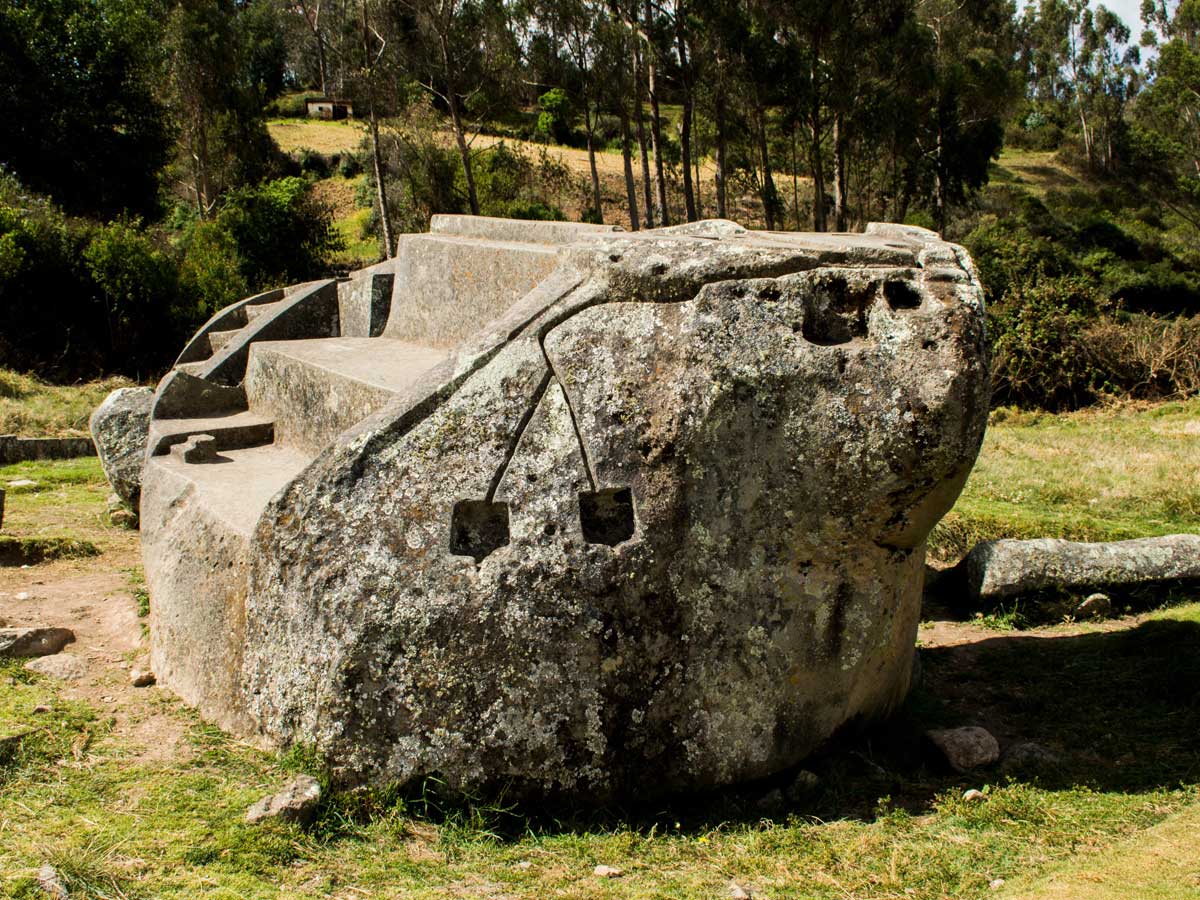Nestled amidst the verdant hills and streams of Apurimac, Peru, lies Sayhuite, an archaeological site that continues to baffle and intrigue historians and archaeologists alike. At the heart of this captivating location stands the Sayhuite Stone, a colossal granite monolith adorned with over 200 mysterious symbols. This enigmatic relic, along with the surrounding ruins, offers a tantalizing glimpse into the sophisticated engineering and cosmological understanding of the Inca civilization.
Location and Description
The Sayhuite site is strategically situated on the ancient route between Cusco and Abancay, in a picturesque setting surrounded by lush greenery and flanked by two streams. The centerpiece of this archaeological wonder is the Sayhuite Stone, a truly impressive structure measuring approximately four meters in diameter and two and a half meters in height.

The upper surface of the stone is intricately carved with an array of symbols, including geometric patterns and zoomorphic reliefs depicting reptiles, frogs, and felines. This intricate iconography has captivated scholars and visitors alike, as they strive to unravel the stone’s enigmatic purpose and significance within the Inca worldview.
Theories and Interpretations
The true purpose of the Sayhuite Stone remains a subject of ongoing debate and scholarly speculation. Some researchers suggest that the stone represents a cosmic model, a physical manifestation of the Inca’s understanding of the living world and its interconnected systems. Others propose that it served as a construction model, complete with detailed representations of aqueducts, irrigation systems, and other engineering marvels.
One prominent theory, put forward by Arlan Andrews, posits that the Sayhuite Stone functioned as a hydraulic topographic model. This hypothesis is supported by the presence of carved terraces, ponds, rivers, tunnels, and irrigation canals on the stone’s surface, indicating its potential use in the study and manipulation of water properties.
Historical Context

According to the renowned historian John Hemming, the Sayhuite site was once presided over by a priestess named Asarpay. Legend has it that upon the arrival of the Spanish, Asarpay chose to throw herself from a nearby waterfall rather than be captured, a testament to the Inca’s unwavering commitment to their cultural and spiritual beliefs.
The temple itself, now devoid of its once-precious gold, is scattered with large carved andesite stones, hinting at a grander past. These remnants serve as a poignant reminder of the devastating impact of colonial conquest on the Inca civilization and the ongoing efforts to preserve and understand their remarkable cultural heritage.
The Archaeological Complex of Sayhuite
The Sayhuite archaeological complex is divided into several distinct sectors, each offering a unique perspective on the site’s history and significance.
Sector I: Monoliths and Enclosures

The primary sector of the Sayhuite complex is situated at a high vantage point, affording a panoramic view of the entire site. Here, visitors can marvel at the main monolith, an ovoid granite structure standing 2.5 meters tall and adorned with a diverse iconography. Surrounding this central monolith are several enclosures, the largest of which is pyramid-shaped and likely served as dwellings for the site’s priestly class.
Sector II: Areas of Stairs and Fountains
This sector features a series of nine fountains aligned from east to west, accompanied by a staircase with sixty-eight steps. The fine masonry of this area, bordered by walls made from precisely cut 0.6 by 0.4-meter tiles, suggests it was used for water rituals, underscoring the importance of water in Inca culture and cosmology.
Sector III: Rumi Huasi Area
Located to the east, the Rumi Huasi area spans approximately 1200 square meters and is home to Monolith II, a rectangular structure adorned with geometric carvings such as platforms, stairs, and circles.

Sector IV: Pyramidal Trunk Definition Area
In the southeast sector of the complex lies the USNU PAMPA, a solid structure measuring 18 by 34 meters. This area was likely used for religious ceremonies dedicated to the sun and water, serving as a place for mass gatherings and worship.
Sector V: Intihuatana Area
Characterized by the presence of the Intihuatana monolith, this sector served as an Inca observatory. The rectangular monolith measures 3.40 meters in length and 0.94 meters in both width and height, and is associated with platform fountains and rooms used for timekeeping.
The Sayhuite Stone: A Closer Look
The Sayhuite Stone, with its impressive dimensions and intricate carvings, is a true marvel of ancient engineering. Measuring nearly two and a half meters in height and with a circumference of eleven meters, the stone’s surface is adorned with over 200 phytomorphic and zoomorphic figures, representing a diverse array of flora, fauna, topography, and human constructions.

These carvings are arranged in an apparent disorder, taking advantage of the stone’s natural reliefs and depressions. Many scholars believe that the Sayhuite Stone represents the Tahuantinsuyo, the Inca Empire, with the carvings depicting the empire’s regions: the highlands (represented by llamas, condors, and pumas), the jungle (represented by monkeys, iguanas, and jaguars), and the coast (represented by pelicans, crabs, and octopuses).
Function and Purpose
The exact function and purpose of the Sayhuite Stone remain elusive, sparking ongoing debate and scholarly investigation. Some theories suggest that it was a scale model used for testing and studying water properties, while others propose that it served as an instructional tool for engineers and technicians. The stone’s carvings have been altered multiple times, indicating that its use and significance evolved over time.
Conclusion
The Sayhuite Stone and its surrounding archaeological complex offer a captivating glimpse into the ingenuity, cosmological beliefs, and reverence for the natural world that characterized the Inca civilization. While much about this enigmatic site remains shrouded in mystery, the stone’s intricate carvings and sophisticated design underscore the Incas’ advanced understanding of engineering and their profound connection to the natural world.
As researchers continue to study and unravel the secrets of the Sayhuite Stone, this remarkable relic stands as a testament to the enduring legacy of the Inca Empire and the enduring human desire to understand the world around us. Whether you’re a history buff, an archaeology enthusiast, or simply someone captivated by the mysteries of the past, the Sayhuite Stone is a must-see destination that promises to ignite your curiosity and inspire your sense of wonder.

